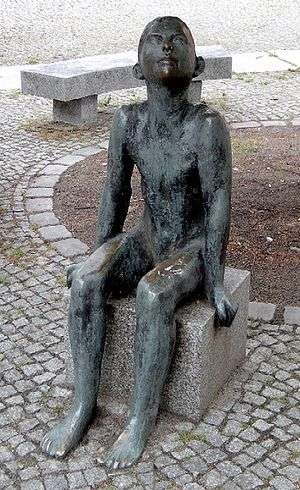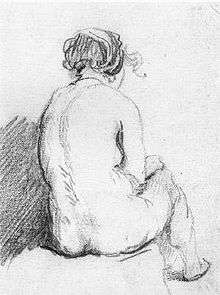Sitting
Sitting is a basic human action and resting position. The body weight is supported primarily by the buttocks in contact with the ground or a horizontal object such as a chair seat. The torso is more or less upright. Sitting for much of the day may pose significant health risks, and people who sit regularly for prolonged periods have higher mortality rates than those who do not.[1]

The form of kneeling where the thighs are near horizontal and the buttocks sit back on the heels, for example as in Seiza and Vajrasana is also often interpreted as sitting.
Prevalence

.jpg)
The British Chiropractic Association said in 2006 that 32% of the British population spent more than ten hours per day sitting down.[2]
Positions
On the floor
The most common ways of sitting on the floor involve bending the knees. One can also sit with the legs unbent, using something solid as support for the back or leaning on one's arms. Sitting with bent legs can be done with the legs mostly parallel or by crossing them over each other.
A common cross-legged position is with the lower part of both legs folded towards the body, crossing each other at the ankle or calf, with both ankles on the floor, sometimes with the feet tucked under the knees or thighs. The position is known in several European languages as tailor style, from the traditional working posture of tailors;[3] compare tailor's bunion. It is also named after various plains-dwelling nomads: in American English Indian style, in many European languages "Turkish style", and in Japanese agura (胡座, The sitting style of non-Han ethnics (particularly Turks, Mongols and other Central Asians.)). In yoga it is known as sukhasana.
On a raised seat
Most raised surfaces at the appropriate height can be used as seats for humans, whether they are made for the purpose, such as chairs, stools and benches, or not. While the buttocks are nearly always rested on the raised surface, there are many differences in how one can hold one's legs and back.
There are two major styles of sitting on a raised surface. The first has one or two of the legs in front of the sitting person; in the second, sitting astride something, the legs incline outwards on either side of the body.
The feet can rest on the floor or on a footrest, which can keep them vertical, horizontal, or at an angle in between. They can also dangle if the seat is sufficiently high. Legs can be kept right to the front of the body, spread apart, or one crossed over the other.
The upper body can be held upright, recline to either side or backward, or one can lean forward.

Yoga, traditions and spirituality


There are many seated positions in various traditions and rituals. Four examples are:
- 正座 (zhengzuo) is a Chinese word which describes the traditional formal way of sitting in Ancient China. A related position is 跪座, which differs in the tops of the feet being raised off the ground.
- Vajrasana (Diamond Pose) is a yoga posture (asana) similar to seiza.
- The lotus position involves resting each foot on the opposite thigh so that the soles of the feet face upwards.
- The Burmese position, named so because of its use in Buddhist sculptures in Burma, places both feet in front of the pelvis with knees bent and touching the floor to the sides. The heels are pointing toward pelvis or upward, and toes are pointed so that the tops of the feet lie on the ground. This looks similar to the cross-legged position, but the feet are not placed underneath the thigh of the next leg, therefore the legs do not cross. Instead, one foot is placed in front of the other.
In various mythologies and folk magic, sitting is a magical act that connects the person who sits with other persons, states or places.[4]
Kneeling chairs
The kneeling chair (often just referred to as "ergonomic chair") was designed to encourage better posture than the conventional chair. To sit in a kneeling chair, one rests one's buttocks on the upper sloping pad and rests the front of the lower legs atop the lower pad, i.e., the human position as both sitting and kneeling at the same time.
Health risks
In 1700, De Morbis Artificum Diatriba, listed sitting in odd postures as a cause of diseases in “chair-workers”.[5] Current studies indicate there is a significantly higher mortality rate among people who regularly sit for prolonged periods, and the risk is not negated by regular exercise, though it is lowered.[1][6] The causes of mortality and morbidity include heart disease, obesity, type 2 diabetes and cancer, specifically, breast, endometrial, colorectal, lung, and epithelial ovarian cancer.[1][6][7][8][9] The link between heart disease and diabetes mortality and sitting is well-established, but the risk of cancer mortality is unclear.[8][10] Sedentary time is also associated with an increased risk of depression in children and adolescents.[11] A correlation between occupational sitting specifically and higher body mass index has been demonstrated, but causality has not yet been established.[6] There are several hypotheses explaining why sitting is a health risk. These include changes in cardiac output, vitamin D, inflammation, sex hormone activity, lipoprotein lipase activity, and GLUT4 activity due to long periods of muscular unloading, among others.[6][8][9]
Sitting may occupy up to half of an adult's workday in developed countries.[6] Workplace programs to reduce sitting vary in method. They include sit-stand desks, counseling, workplace policy changes, walking/standing meetings, treadmill desks, breaks, therapy ball chairs, and stepping devices.[7][12] Results of these programs are mixed,[7] but there is moderate evidence to show that changes to chairs (adjusting the biomechanics of the chair or using different types of chairs) can effectively reduce musculoskeletal symptoms in workers who sit for most of their day.[13]
Public health programs typically focus on increasing physical activity rather than reducing sitting time.[1][14] One major target for these public health programs is sitting in the workplace.[7][12] For example, WHO Europe recommended in September 2015 the provision of adjustable desks in the workplace.[14] In general, there is conflicting evidence regarding the precise risks of sitting for long periods.[6] A 2018 Cochrane review found low-quality evidence that providing employees with a standing desk option may reduce the length of time some people sit at work in the first year.[12] This reduction in sitting may decrease with time, and there is no evidence that standing desks are effective in the long term.[12] In addition, a 2018 British Journal of Medicine systematic review concluded that interventions aimed at reducing sitting outside of work were only modestly effective.[15] It is not clear how standing desks compare to other work-place interventions to reduce the length of time employees are sitting during the work day.[12]
Relationship between posture and health conditions
Though most studies even until early 21st century relate human body postures to various musculoskeletal conditions, recent researches show no potential causal relationship between postures and these conditions like back pain;[16] other causes like sleep deprivation, stress and long-term physical inactivity or prolonged static unnatural postural stress could be significant confounders for various health conditions.[17] However some research show that prolonged slouched position may be a cause for minor breathing disorders.[18] Though still a large proportion of the clinical practitioners attribute absence of a neutral spine posture as one of the main causes of conditions like back pain and neck pain, the relationship is not thoroughly established. It is also thought that much of so-called “poor posture” is actually just postural stress and being stuck with bad ergonomics that could be causing the pain — not really a postural problem.[19] iHunch is an example of postural stress which could cause upper back pain and neck pain, which is prevalent in younger generations and people whose occupation involves prolonged usage of computers.
See also
- Baddha Koṇāsana
- Bharadvajasana
- Coccydynia
- Flandrin pose
- Siddhasana
- Sitting disability
- Sitting on one's haunches
References
- Biswas, A; Oh, PI; Faulkner, GE; Bajaj, RR; Silver, MA; Mitchell, MS; Alter, DA (2015). "Sedentary Time and Its Association With Risk for Disease Incidence, Mortality, and Hospitalization in Adults: A Systematic Review and Meta-analysis". Annals of Internal Medicine. 162 (2): 123–32. doi:10.7326/M14-1651. PMID 25599350.
- "Sitting straight 'bad for backs'". BBC. November 28, 2006. Retrieved February 20, 2015.
- "The Art of the Cut". History.org. Retrieved 2012-03-16.
- Čajkanović, Veselin (1996). Translated by Živković, Marko. "Magical Sitting". Anthropology of East Europe Review. 14 (1). Archived from the original on 2007-07-03. Retrieved 2007-07-09.
It is obvious from all the above that sitting, seen from the viewpoint of the history of religion, could be a magical act which, within the framework of analogic magic, will establish a certain relationship, a covenant.
- Ramazzini, B. (2001). "De Morbis Artificum Diatriba Diseases of Workers". American Journal of Public Health. 91 (9): 1380–1382. doi:10.2105/AJPH.91.9.1380. PMC 1446785. PMID 11527762.
- van Uffelen, Jannique G. Z.; Wong, Jason; Chau, Josephine Y.; van der Ploeg, Hidde P.; Riphagen, Ingrid; Gilson, Nicholas D.; Burton, Nicola W.; Healy, Genevieve N.; Thorp, Alicia A. (Oct 2010). "Occupational sitting and health risks: a systematic review". American Journal of Preventive Medicine. 39 (4): 379–388. doi:10.1016/j.amepre.2010.05.024. ISSN 1873-2607. PMID 20837291.
- Chau, Josephine Y.; der Ploeg, Hidde P. van; van Uffelen, Jannique G. Z.; Wong, Jason; Riphagen, Ingrid; Healy, Genevieve N.; Gilson, Nicholas D.; Dunstan, David W.; Bauman, Adrian E. (Nov 2010). "Are workplace interventions to reduce sitting effective? A systematic review". Preventive Medicine. 51 (5): 352–356. doi:10.1016/j.ypmed.2010.08.012. ISSN 1096-0260. PMID 20801153.
- Proper, Karin I.; Singh, Amika S.; van Mechelen, Willem; Chinapaw, Mai J. M. (Feb 2011). "Sedentary behaviors and health outcomes among adults: a systematic review of prospective studies". American Journal of Preventive Medicine. 40 (2): 174–182. doi:10.1016/j.amepre.2010.10.015. ISSN 1873-2607. PMID 21238866.
- Lynch, Brigid M. (Nov 2010). "Sedentary behavior and cancer: a systematic review of the literature and proposed biological mechanisms". Cancer Epidemiology, Biomarkers & Prevention. 19 (11): 2691–2709. doi:10.1158/1055-9965.EPI-10-0815. ISSN 1538-7755. PMID 20833969.
- Wilmot, E. G.; Edwardson, C. L.; Achana, F. A.; Davies, M. J.; Gorely, T.; Gray, L. J.; Khunti, K.; Yates, T.; Biddle, S. J. H. (14 August 2012). "Sedentary time in adults and the association with diabetes, cardiovascular disease and death: systematic review and meta-analysis" (PDF). Diabetologia. 55 (11): 2895–2905. doi:10.1007/s00125-012-2677-z. PMID 22890825.
- Liu, M; Wu, L; Yao, S (9 November 2015). "Dose-response association of screen time-based sedentary behaviour in children and adolescents and depression: a meta-analysis of observational studies". British Journal of Sports Medicine. 50 (20): 1252–1258. doi:10.1136/bjsports-2015-095084. PMC 4977203. PMID 26552416.
- Shrestha, Nipun; Kukkonen-Harjula, Katriina T.; Verbeek, Jos H.; Ijaz, Sharea; Hermans, Veerle; Pedisic, Zeljko (2018-06-20). "Workplace interventions for reducing sitting at work". The Cochrane Database of Systematic Reviews. 6: CD010912. doi:10.1002/14651858.CD010912.pub4. ISSN 1469-493X. PMC 6513236. PMID 29926475.
- van Niekerk, Sjan-Mari; Louw, Quinette Abigail; Hillier, Susan (2012). "The effectiveness of a chair intervention in the workplace to reduce musculoskeletal symptoms. A systematic review". BMC Musculoskeletal Disorders. 13: 145. doi:10.1186/1471-2474-13-145. ISSN 1471-2474. PMC 3552974. PMID 22889123.
- Europe, WHO (September 2015). "World Health Organization" (PDF). WHO. WHO. Retrieved October 7, 2015.
- Shrestha, N; Grgic, J; Weisner, G; Parker, A; Podnar, H; Bennie, J; Biddle, SJH; Pedisic, Zeljko (13 January 2018). "Effectiveness of interventions for reducing non-occupational sedentary behaviour in adults and older adults: a systematic review and meta-analysis". British Journal of Sports Medicine. 53 (19): bjsports–2017–098270. doi:10.1136/bjsports-2017-098270. PMID 29331992.
- Lederman, Eyal (April 2011). "The fall of the postural-structural-biomechanical model in manual and physical therapies: exemplified by lower back pain". Journal of Bodywork and Movement Therapies. 15 (2): 131–138. doi:10.1016/j.jbmt.2011.01.011. ISSN 1532-9283. PMID 21419349.
- "Are you sitting comfortably: the myth of good posture". the Guardian. 5 March 2018.
- Albarrati, Ali; Zafar, Hamayun; Alghadir, Ahmad H.; Anwer, Shahnwaz (2018). "Effect of Upright and Slouched Sitting Postures on the Respiratory Muscle Strength in Healthy Young Males". BioMed Research International. 2018: 3058970. doi:10.1155/2018/3058970. PMC 5845520. PMID 29682532.
- "Posture Correction: Does it matter?".
Further reading
- Chau JY, der Ploeg HP, van Uffelen JG, Wong J, Riphagen I, Healy GN, Gilson ND, Dunstan DW, Bauman AE, Owen N, Brown WJ (2010). "Are workplace interventions to reduce sitting effective? A systematic review". Preventive Medicine. 51 (5): 352–6. doi:10.1016/j.ypmed.2010.08.012. PMID 20801153.
- Chinapaw MJ, Proper KI, Brug J, van Mechelen W, Singh AS (2011). "Relationship between young peoples' sedentary behaviour and biomedical health indicators: a systematic review of prospective studies". Obesity Reviews. 12 (7): e621–32. doi:10.1111/j.1467-789X.2011.00865.x. PMID 21438990.
- Proper KI, Singh AS, van Mechelen W, Chinapaw MJ (2011). "Sedentary behaviors and health outcomes among adults: a systematic review of prospective studies". American Journal of Preventive Medicine. 40 (2): 174–82. doi:10.1016/j.amepre.2010.10.015. PMID 21238866.
- Roffey DM, Wai EK, Bishop P, Kwon BK, Dagenais S (2010). "Causal assessment of occupational sitting and low back pain: results of a systematic review". The Spine Journal. 10 (3): 252–61. doi:10.1016/j.spinee.2009.12.005. PMID 20097618.
- Shrestha, N; Kukkonen-Harjula, KT; Verbeek, JH; Ijaz, S; Hermans, V; Pedisic, Z (20 June 2018). "Workplace interventions for reducing sitting at work". The Cochrane database of systematic reviews. 6: CD010912. doi:10.1002/14651858.CD010912.pub4. PMID 29926475.
External links

